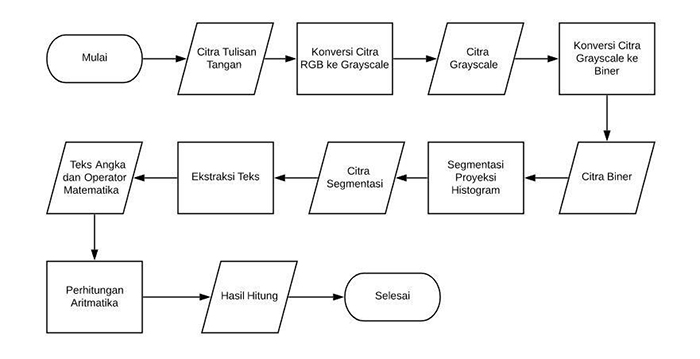Simple Handwriting Calculator Application Using Optical Character Recognition (OCR)
DOI:
https://doi.org/10.12928/biste.v2i3.3348Keywords:
Image Processing, Optical Character Recognition, Handwritten RecognitionAbstract
The calculator is a calculation tool that is widely used in various specialized fields of business and commerce. The use of a calculator makes it easier for humans to perform calculation operations, but there are obstacles in the process of inputting numbers if you want to calculate the value of numbers on written media such as paper, whiteboards and so on. The user must first see the text on written media, then read it and remember it then type the writing on a calculator tool or application. The drawback of this method is that when the user forgets the writing on the written media, the user will see the written text and remember it again so that it takes longer to perform calculations using a calculator. The method used in this study is Optical Character Recognition, this method can recognize text contained in images or handwritten images of mathematical number operations. The results of the introduction of the text will then be carried out by arithmetic calculations to get the calculation results. From the trials on 20 handwritten images of mathematical number operations, the results obtained were 85% accuracy of extraction and accuracy of handwritten images that can be calculated and correct by 85%.References
L. Ratnasari dan A. G. Abbasi, “Perancangan Aplikasi Kalkulator Penilaian Kategorisasi Data Berbasis Android,” JURNAL ILMIAH INFORMATIKA KOMPUTER, vol. 2, no. 23, 2018.
M. Maskuri, “Implementasi Metode Template Matching Untuk Media Pembelajaran Pengenalan Karakter Huruf Alphabet,” Simki-Techsain, p. 11, 2017.
Mahmudi, “Aplikasi MATLAB untuk Mengenali Karakter Tulisan Tangan,” MATICS, vol. 1, no. 9, p. 18, 2017.
Liantoni, “Pengenalan karakter angka menggunakan metode Integral Proyeksi,” Jurnal Ilmiah Teknologi Sistem, p. 57, 2017.
M. Rohmah, “Perancangan Aplikasi Game Aritmatika Dasar Berbasis Android,” J. Saintek, vol. 13, no. 1, pp. 36-43, 2016.
Maria, “Segmentasi Citra Digital Bentuk Daun Pada Tanaman Di Politani Samarinda Menggunakan Metode Thresholding,” Jurti, vol. 2, no. 1, p. 37–46, 2018.
Masrani, “ Aplikasi Pengenalan Pola Pada Huruf Tulisan Tangan Menggunakan Jaringan Saraf Tiruan Dengan Metode Ekstraksi Fitur Geometri,” Sistem Komputer Untan, vol. 02, no. 06, p. 69–78, 2018.
Septiarini, “Segmentasi Karakter Menggunakan Profil Proyeksi,” Jurnal Informatika Mulawarman, vol. 2, no. 7, pp. 66-69, 2012.
Setiawan, “ Implementasi Optical Character Recognition (OCR) pada Mesin Penerjemah Bahasa Indonesia ke Bahasa Inggris,” urnal Sistem Dan Teknologi Informasi (JUSTIN), vol. 2, no. 5, pp. 135-141, 2017.
M. Fauzi, “Mengubah Tulisan Tangan Menjadi Text Digital Ocr (Optical Character Recognition) Dengan Menggunakan Metode Segmentasi Dan Korelasi,” Transient,Sistem, pp. 1-5, 2014.
P. Chakraborty, “An Open Source Tesseract based Tool for Extracting Text from Images with Application in Braille Translation for the Visually Impaired,” International Journal of Computer Applications, vol. 16, no. 68, pp. 26-32, 2013.
F. N. Fajri dan W. J. Shudiq, “Aplikasi" Fire Bus" Sebagai Media Penyampaian Informasi Keberangkatan Bis Secara Realtime Menggunakan Notifikasi Berbasis Android,” Nusantara Journal of Computers and Its Applications, vol. 4, no. 2, pp. 85-91, 2019.

Downloads
Published
How to Cite
Issue
Section
License
Copyright (c) 2021 supriadi adi

This work is licensed under a Creative Commons Attribution-ShareAlike 4.0 International License.
Authors who publish with this journal agree to the following terms:
- Authors retain copyright and grant the journal right of first publication with the work simultaneously licensed under a Creative Commons Attribution License that allows others to share the work with an acknowledgment of the work's authorship and initial publication in this journal.
- Authors are able to enter into separate, additional contractual arrangements for the non-exclusive distribution of the journal's published version of the work (e.g., post it to an institutional repository or publish it in a book), with an acknowledgment of its initial publication in this journal.
- Authors are permitted and encouraged to post their work online (e.g., in institutional repositories or on their website) prior to and during the submission process, as it can lead to productive exchanges, as well as earlier and greater citation of published work (See The Effect of Open Access).
This journal is licensed under a Creative Commons Attribution-ShareAlike 4.0 International License.


